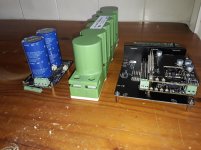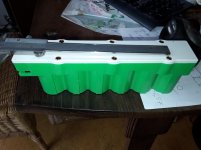Thanks for the write up Simon, may be add an example with the DDDAC
A 4 deck dddac consumes like 1A. My own DDDAC power supply can deliver a bit above this when needed. So there is little headroom for charging a ultracap bank with 6x500F. This might take like 20 minutes.
In stead the management module connects a fast charger. I used a LED driver with CVCC delivering more than 10A, charging the ultra pro in 45 secs to 12 volt. From that point the dddac “audiophile” psu takes over and keeps the ultracap on charge. In the same time the PI is booting, so you can start enjoying music roughly at the same time as normal
Ok, I see, the use of this module is only for situations where the PSU gets turned on and off frequently. My DDDAC is always on, that's why I asked about using a bench/lab power supply to charge the ultra caps for the first time, and then keep them charged with the "audiophile" PSU.
But... since you already have a RPi, why don't you use this to handle the charging / switching? I don't see why you need the extra Arduino and a dedicated board. You could use the RPi with a simple PSU that has a USB interface to handle and monitor the quick charge, and then switch over to the "audiophile" PSU using a relay.
Hello,
My idea that most technically orientated people can't or do not read properly is confirmed again. lol.
The problem is that most supplies used by DDDAC owners wont like being faced by the task of charging a cap like the 61,7F 18 volt that i will be using for my 16,5 volt 300mA supply for Andrea's clock boards. The CC supply Doede is using can supply a beefy current to '' fill up '' the supercap while the DDDAC mainboard is also connected.
When CC task is done the ''normal supply '' can do its job properly.
Greetings, Eduard
My idea that most technically orientated people can't or do not read properly is confirmed again. lol.
The problem is that most supplies used by DDDAC owners wont like being faced by the task of charging a cap like the 61,7F 18 volt that i will be using for my 16,5 volt 300mA supply for Andrea's clock boards. The CC supply Doede is using can supply a beefy current to '' fill up '' the supercap while the DDDAC mainboard is also connected.
When CC task is done the ''normal supply '' can do its job properly.
Greetings, Eduard
My idea that most technically orientated people can't or do not read properly is confirmed again. lol.
Sorry, but this pisses me off big time. Not funny at all.
I simply asked for some background and context of how/where this module would be useful.
In addition your "explanations" completely miss my points. It seems you did not read/understand my post at all.
Hello,
Sorry here too no reason to consider everything so seriously.
Probably caused by a state of hypoglycemia.
Greetings,Eduard
P.s so better wait for Simon or Doede to explain
Sorry here too no reason to consider everything so seriously.
Probably caused by a state of hypoglycemia.
Greetings,Eduard
P.s so better wait for Simon or Doede to explain
But... since you already have a RPi, why don't you use this to handle the charging / switching? I don't see why you need the extra Arduino and a dedicated board. You could use the RPi with a simple PSU that has a USB interface to handle and monitor the quick charge, and then switch over to the "audiophile" PSU using a relay.
Sure this could have been done. There was no decision "against" a solution like that - like better or not decision - but in that case it would have been a specialized, isolated solution where a Berry streamer is at hand. I just wanted to have something stand-alone, easy to experiment with and which is flexible in regard to the "audio" PSU and the "dirty" charger and can be used in other applications as well (clock, Phono amplifier, test set-up etc etc)
I choose for Arduino, as I am very familiar with the coding and hardware and it is incredibly cheap to implement embedded on a PCB. Cheaper as any discrete, digital/analog solution with logic and or opamps and transistors for example.
anyway, the thing from many ways to Rome I could say.
Hello,
Some pics of my 61,7F 18 volt supercap that will be used for feeding the set of " clock boards " from Andrea.
As you can see they are build with some safety features. 6 holes for mounting, protected terminal with nice bolts.
Greetings,Eduard
Some pics of my 61,7F 18 volt supercap that will be used for feeding the set of " clock boards " from Andrea.
As you can see they are build with some safety features. 6 holes for mounting, protected terminal with nice bolts.
Greetings,Eduard

